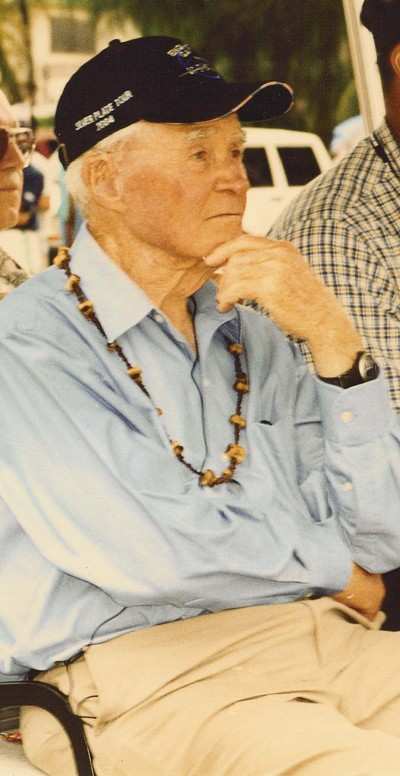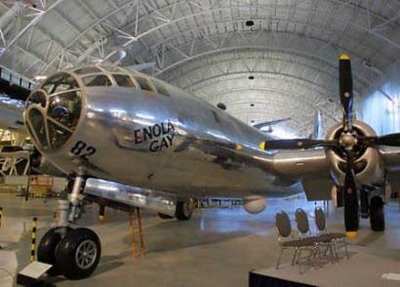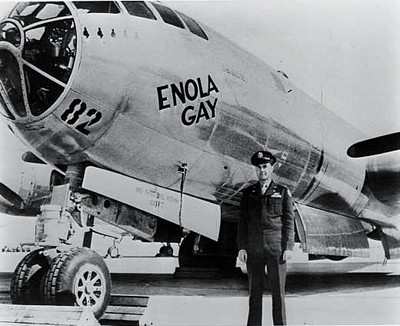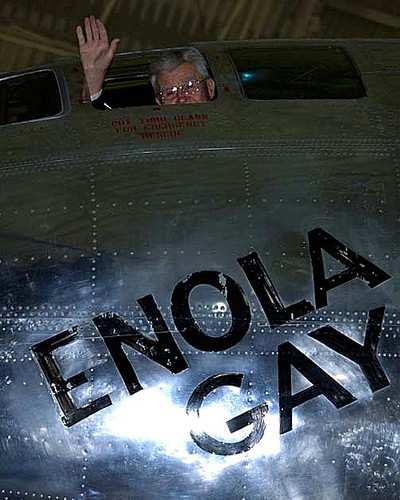Enola Gay Pilot To Share Memories At Florida Air Show
General Paul Tibbets, the man who piloted the first atomic
bombing mission over Hiroshima, Japan in 1945, will be on hand at
the TICO Air Show in Titusville, FL, this weekend to sign books and
talk about his colorful career.
General Tibbets’ illustrious career has been overshadowed
by the role he and his fellow crewmembers played in ending World
War II. Tibbets played a key role in one of the most important
periods in the history of our country.

General Tibbets was born in 1915 in Quincy, IL, and after his
early schooling, graduated from Western Military Academy in Alton,
IL, in 1933. At the age of eighteen, General Tibbets attended the
University of Florida and the University of Cincinnati, the latter
as a Chemistry major. Tibbets entered the Army Air Corps on
February 25, 1937, and began his flying school at Randolph Field,
TX, before graduating from pilot school at Kelly Field, TX, in
February 1938.
At the outbreak of World War II, General Tibbets formed an
anti-submarine patrol squadron at Pope Field, Fort Bragg, NC. In
June 1942, he arrived in England and flew 25 combat missions over
the European continent, including the first American B-17 Flying
Fortress raid against occupied Europe -– a bombing mission
that was led by General Ira C. Eaker. In the fall of 1942, Tibbets
was assigned to fly General Mark Clark to his meeting with the
French prior to the invasion of North Africa.

In the month that followed, General Tibbets conducted bombing
missions over North Africa under direct control of the British,
including the first heavy bombardment mission in support of the
North African invasion. In March 1943, General Tibbets returned to
the United States as a B-29 Program flight test pilot, where he
worked with Boeing and the Air Materiel Command until March, 1944,
when he was transferred to Grand Island, Nebraska. There he became
Director of Operations for a B-29 instructor transition school
under General Frank Armstrong.
In September 1944, Paul Tibbets was briefed on the Manhattan
Project, the code name for the development of the atom bomb. It was
to be his responsibility to organize and train a unit to deliver
these weapons in combat operations. He would also determine and
supervise the modifications necessary to make the B-29 capable of
delivering the weapons, and for this, the unit had to be
self-sufficient.

Secrecy was paramount. The unit would support Los Alamos with
flight test airplanes to establish ballistics and detonator
reliability to explode the bombs.
Tibbets was told, "You are on your own. No one knows what to
tell you. Use normal channels to the extent possible. If you are
denied something you need, restate your need is for 'SILVERPLATE'
(a code name) and your request will be honored without
question."
Paul Tibbets requisitioned 15 new B-29s and specified they be
stripped of turrets and armor plating except for the tail gunner
position; that fuel-injected engines and new technology reversible
pitch propellers be installed; and the bomb bay re-configured to
suspend, from a single point, ten thousand pounds. Such an airplane
would fly higher, faster, and above the effective range of
anti-aircraft fire.
A B-29 bombardment squadron, the 393rd, in its final stage of
training, and Wendover Army Air Base located on the Utah/Nevada
border were selected by Paul for "starters". The 393rd was fully
equipped and the base had a fully manned "housekeeping" group.
Wendover was isolated but close enough to Los Alamos to work
together. The Salton Sea was an ideal distance for bombing
practice. Then on December 17th, 1944, formal orders were issued
activating the 509th Composite Group, consisting of seven
subordinate units. In March 1945 the First Ordnance Squadron, a
unit designed to carry out the technical phases of the group
responsibilities, became part of the 509th. The personnel count now
exceeded 1500 enlisted men and some 200 officers.
Quietly, the group started moving overseas to Tinian Island in
the Marianas chain. On the afternoon of August 5th, 1945, President
Truman gave his approval to use the weapons against Japan. By the
time the plane left, it’s familiar arrowhead tail motif had
been changed on both sides to the letter "R" in a circle, the
standard i.d. for the Sixth bomb group. The idea behind the change
was to confuse the enemy if they made contact, which they did
not.
At 02:45 August 6th, the Enola Gay lifted off North Field with
Paul Tibbets and his crew en route to Hiroshima. At exactly 09:15
plus 15 seconds the world’s first atomic bomb exploded. The
course of history and the nature of warfare was changed. The Enola
Gay landed back at Tinian at 2:58 P.M. and the plane and crew were
greeted by General Spaatz, a large contingent of brass, and
jubilant GIs. General Spaatz decorated Tibbets with the
Distinguished Service Cross and the other crewmembers with Air
Medals.
This tremendous accomplishment, which not only affected the
outcome of World War II but also altered the history of the world,
was not merely a single event. Rather, it was a culmination of
events throughout which Paul Tibbets played a pivotal role.

Following the end of the war in 1945, General Tibbets was a
technical adviser to the Air Force commander in charge of the
Bikini Bomb Project from 1945-46. After an assignment as Director
of the Strategic Air Division, Directorate of Requirements,
Headquarters US Air Force, from July 1950 until February, 1952,
General Tibbets was assigned as B-47 Project Officer at the Boeing
Airplane Company, Wichita, Kansas, during the service test of the
B-47 Stratojet to determine its operational suitability. General
Tibbets later returned to Europe as Director of War Plans for the
Allied Air Forces in Central Europe, at Fontainebleau, France.
He returned to the United States in 1956, as Commander of the
308th Bomb Wing, Hunter Air Force Base, GA. In January 1958, he was
reassigned as Commander of the 6th Air Division, where he earned
the rating of command pilot. In February 1961, General Tibbets was
assigned once again to Headquarters, US Air Force, this time as
Director of Management Analysis. In July 1962, General Tibbets was
assigned to the Joint Staff, Organization of the Joint Chiefs of
Staff, as Deputy Director for Operations, J-3. In June 1963,
following the reorganization of the Operations Directorate, Joint
Staff, General Tibbets became the new Deputy Director for the
National Military Command System.
When Paul Tibbets retired from the US Air Force on August 31st,
1966, he had completed more than 29 and one-half years of service,
but he was not through flying. Initially he resided in Geneva,
Switzerland, operating three Lear jets throughout central Europe.
There, he helped to educate the air ministries about the
jet’s uses. He also advised the air ministries about the
aviation controls and guidelines they later instituted within their
countries.
Back in Columbus, OH, in 1970, Paul joined Executive Jet
Aviation, an all-jet air taxi service company, where he served in
different capacities. Tibbets rose up the corporate ladder to
become Chairman of the Board in 1982. The company changed ownership
in 1985 and Paul retired again. During his 15 years Paul Tibbets
acquired almost 400 hours in Lear jets, flying with an Air
Transport Pilot rating. As pilot of one of the most famous flights
of WW II, which brought about a quicker surrender from the enemy
and a reduction in the loss of Allied lives, and for his leadership
and skill with both airplanes and people in times of stress, Paul
W. Tibbets, Jr. is enshrined with honor into the National Aviation
Hall of Fame.
 ANN's Daily Aero-Linx (04.13.24)
ANN's Daily Aero-Linx (04.13.24) ANN's Daily Aero-Term (04.13.24): Beyond Visual Line Of Sight (BVLOS)
ANN's Daily Aero-Term (04.13.24): Beyond Visual Line Of Sight (BVLOS) Airborne 04.09.24: SnF24!, Piper-DeltaHawk!, Fisher Update, Junkers
Airborne 04.09.24: SnF24!, Piper-DeltaHawk!, Fisher Update, Junkers Aero-News: Quote of the Day (04.14.24)
Aero-News: Quote of the Day (04.14.24) ANN's Daily Aero-Term (04.14.24): Maximum Authorized Altitude
ANN's Daily Aero-Term (04.14.24): Maximum Authorized Altitude






